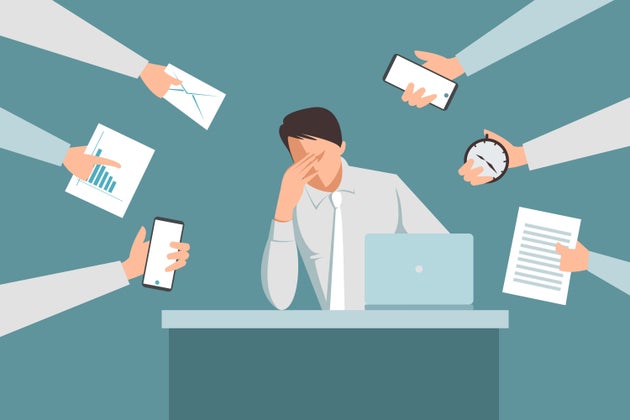At 25 years old, Mitch Wallis was climbing the ranks at Microsoft, flying business class, meeting celebs and pitching snazzy new products to Silicon Valley bigwigs.
But beneath the surface of his seemingly Instagram-perfect life, there was turmoil.
“I had no much responsibility as a 25-year-old. My ego loved it, but my body started to feel the impacts,” the Sydney mental health advocate told HuffPost Australia.
“For me, what that looked like was all my underlying mental health issues surfacing, being aggravated and all aspects of my life deteriorating as a result of that.”
Wallis has suffered from mental illness from the age of seven. He was diagnosed with obsessive-compulsive disorder after his mum saw him repetitively touching objects and blinking, but he said it came to the surface when the pressure of his corporate life pushed him to the brink in his mid-twenties.
“Not just the sheer demand of work but also my own expectation and the culture of performance trying to deliver at a particular level,” he said of his first experience with burnout. “It started to take its toll.”
Living away from family in the United States, Wallis was so burnt out from work stress he became incapacitated and ended up in an outpatient clinic in Louisville, Kentucky, for treatment. Looking back his clearest memory was telling his mum over the phone, “I don’t think I can recover from this.”
Wallis did recover and now dedicates his life’s work to empowering young people to share their mental health stories through his charity Heart On My Sleeve.
We spoke to Wallis and other experts about how to spot signs of burnout and manage it when it sneaks up:
What actually is burnout?
Last year, burnout was classified by the World Health Organisation (WHO) as an “occupational phenomenon”, legitimising the experiences of many who’ve fallen prey to the problem, also known as vital exhaustion.
“Burnout is a syndrome conceptualised as resulting from chronic workplace stress that has not been successfully managed,” said WHO.
What are the signs of burnout?
Burnout may feel like reduced enthusiasm for work you previously felt passionate about, Wallis explained.
“Despising work and seeing it as the enemy, physical exhaustion or sickness, reduced performance and engagement are signs,” he said, adding, “It can also look like a spike of traditional mental ill health symptoms, like anxiety, agitation or depression.”
Burnout is different for everyone, so it’s important to check in with how you’re feeling and be aware if your feelings or behaviour change. If you do notice a change, don’t ignore it.
“For me, it starts with sleep disruption, irritability and general anxiety,” Wallis said. “As it starts to ramp, it gets more acute where my obsessional thinking will increase. My ability to drop certain scenarios or thoughts from my head becomes more difficult. I’ll start to feel depressed for no real reason, and I get depersonalisation, where I feel slightly dissociated and numb to a point of it completely intruding on my life.”
Strategies to prevent it
Slow down
“We live in an age of this unrealistic expectation and perception of the rise-and-grind young working professional,” Wallis said.
“Not everything has to be done today. We don’t need to self-actualise this week. Become a ruthless prioritiser and know what 20% of things are going to give you 80% of the outputs I need.”
Ask yourself, ‘Why am I doing this?’
“Ask yourself what is the reason for this relentless pursuit or pace that you are willing to sacrifice your own health or happiness for? And also, ‘Who are you doing this for?’” Wallis said.
“Your duty is to find that line and have the awareness and discipline to know when the unhelpful narratives and belief systems have taken control.”
While acknowledging that corporations strain employees with job demands and inflexibility and that workplaces have a long way to be accountable for their staff members’ mental health, it’s ultimately up to the employee to figure out what’s driving them and set boundaries.
Build your identity outside of work
“What are you doing outside of the outside to get more value and worth on the inside?” Wallis asked. “Hobbies, learning, relationships, being a good human to your fellow humans. These matter the most.”
Burnout is often close when you start living for the weekend and have an all-or-nothing way of thinking. “When people say, ‘I hate Mondays,’ or ‘Thank God it’s Friday,’ these are cute little sayings, but what you’re telling yourself is, ’80% of my life sucks,’” said clinical psychologist Ryan Howes.
Bringing your weekend into your week and finding engagement elsewhere can be part of this strategy.
“If your weekends are filled with connecting with friends and getting some rest and going on little adventures, fantastic. How can you make that part of your workweek?” Howes said. Examples Howes offered are getting breakfast with a non-work friend or going to a bookstore on your lunch break.
Don’t do it alone
“There is an old saying: ‘If you want to go fast, go alone. If you want to go far, go together’,” Wallis said.
“Vulnerability is key. Being able to say, ‘Hey, I need help on this’ is so important.’”
Wallis added that many people believe in this concept but don’t take action it.
“Nothing good, and I mean nothing, comes from a single person. Everything is a team effort, and we need to lean on each other when we are tired so we can be in it for the marathon, not the sprint.”
Take self-care seriously and don’t compromise on it
“Self-care is both reactive and proactive,” Wallis explained.
“Reactive self-care are our go-to tools, people and mindsets that help us regain strength and stability. They are the things that put us back in a headspace of ‘I got this. I can cope.’
“Proactive is our work stream to ensure there is an always-on solid foundation that we can use to thrive and not just avoid pitfalls ― from cold showers to exercise and everything in between ― it’s the things we do no matter how we are feeling so that we have buffer room or a savings reserve of energy to tap into when we need it.
“Even if we have these plans or habits, they are useless unless we action them. Discipline and not compromising is the difference between success and failure in avoiding burnout.”

And if you’re already burnt out?
Taking holiday is a good place to start, especially if you’re working from home or suffering coronavirus-related mental issues. “Many people have taken their holiday leave, even though they have nowhere to go,” said psychotherapist Lucy Fuller.
“This might sound mad and a waste of holiday leave, but it makes good sense in terms of taking a break and doing something different for a few days away from the pressures of work.”
Practising mindfulness can help you live in the moment rather than thinking about the endless Zoom meetings you’ve got coming up. And practising gratitude can promote feelings of positivity: Write down three things that went well today or for which you’re grateful.
Breathing exercises are useful when you feel overwhelmed, so take five minutes out of your day, sit comfortably somewhere and focus on your breath. There are a number of deep breathing apps you can download on your phone to help guide you, or you can find some helpful breathing exercises here.
And if none of this helps and your stress is causing you distress, speak to your GP, who can offer psychological support.


